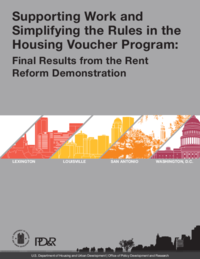Supporting Work and Simplifying the Rules in the Housing Voucher Program
Final Results from the Rent Reform Demonstration

Launched in 2015, the Rent Reform Demonstration tested whether an alternative rent-setting policy for the Housing Choice Voucher (HCV) program could provide incentives for employment and income growth for tenants and make it easier for public housing agencies (PHAs) to administer the program, while avoiding unnecessary hardship on assisted families. More than 6,600 families at four PHAs participated in the demonstration.
As families were enrolled in the study, they were randomly assigned either to a group subject to a new rent policy or to a control group that continued with the existing rent policy. Under the existing rent calculations, most households (excluding older adults and people with disabilities) are required to report their income to the PHA at least annually, with increases in income translating to the household paying a higher share of the rent. The new rent policy calculated rents based on families’ prior-year income rather than anticipated income; eliminated deductions from income; slightly lowered the percentage of income that would be paid toward rent; introduced or increased the minimum dollar amount families were required to pay toward their rent and utilities; and, most notably, did not require families to report increases in income for three years, compared with annually under regular rent rules.
The final evaluation of the demonstration showed that the new rent model did not cause tenants to increase their earnings or employment after six years. However, voucher families and PHA staff members preferred the alternative rent model, and PHAs reported a reduction in administrative burden. Many families interviewed said the new rent policy reduced stress and gave them a little more money each month. For PHAs, the new rent policy reduced certain time-consuming administrative activities, including regular recertifications and the need for frequent actions related to interim changes in families’ income. Families who were assigned to the new rent policy also remained on housing assistance somewhat longer than families who were not; however, the new policy did not increase program costs over the long term. Other studies have documented the positive benefits of receiving housing assistance (including extra years of assistance) on housing stability and other positive outcomes for households with extremely low incomes.







